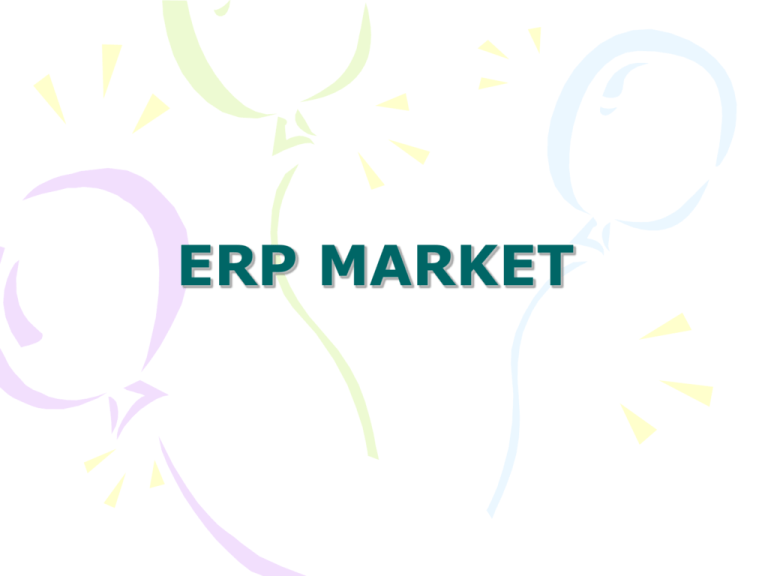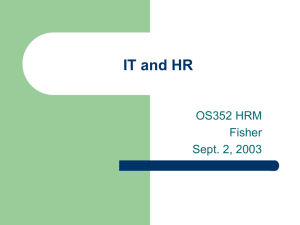SAP
advertisement

ERP MARKET Some of the top-tier ERP vendors are SAPAG, BAAN, PeopleSoft, Oracle Application and J.D.Edwards. These companies are covering the major ERP market revenue. SAP AG:COMPANY PROFILE SAP (System Applications & Products in data processing) . SAP is the world's leading provider of business software, SAP delivers products and services that help accelerate business innovation for their customers. Today, more than 82,000 customers in more than 120 countries run SAP applications – from distinct solutions addressing the needs of small businesses and midsize companies to suite offerings for global organizations. SAP defines business software as comprising enterprise resource planning and related applications such as supply chain management, customer relationship management, and supplier relationship management • SAP AG was founded in 1972 by five German engineers with IBM in Mannheim, Germany; and is one of the top most ERP vendors providing the client server business application solutions. • SAP serves as a standard in the industries like chemicals, customer products, oil & high technology. The SAP group has offices in more than 50 countries worldwide & employs a workforce of over 19300. • SAP’s ERP package comes in 2 versions i.e. mainframe version (SAP R/2) & client server version (SAP R/3).(RReal) • With SAP, customers can install the core system & one or more of the fundamental components, or purchase the software as a complete package. PRODUCTS & TECHNOLOGY • SAP has developed extensive library of more than 800 predefined business processes. • These processes may be selected from SAP library & can be included within installed SAP application solution to suit the user exact requirements. • SAP software has special features like, linking a company’s business processes & applications, & supporting immediate responses to change throughout different organizational levels & real time integration. • Also, the new technologies are available regularly to cop-up with the changes of the new business trends. • The international standards have been considered while designing the software like support of multiple currencies simultaneously, automatically handles the country specific import/export requirements • The modules of R/3 can be used individually as well as user can expand it in stages to meet specific requirement's R/2 in the Late 1970s In 1978 SAP began developing, and the following year released, R/2 (R for "realtime"), a mainframe-based, standard business software suite in which Integrate able modules for accounting, sales and distribution, and production enabled customers to consolidate their financial and operational data into a single database and eliminate costly paperwork and data entry. Because the modules were self-standing, businesses could select only those they needed, which could then be further customized to their unique requirements. R/3 Development in the 1980s • As R/2's potential began to peak in the mid-1980s, Plattner and company's former employer, IBM, announced a new "system applications architecture" (SAA) technology Seeing the ramifications of such integrity ability for its own products, in 1987 SAP began developing R/3 for use in the decentralized, non-mainframe computing environment known as client-server. In client-server arrangements, data is processed not by a single costly mainframe but by many cheaper networked "server" computers, which display their data on flexibly arrange able PCs called "clients." While R/2 focused on providing data processing solutions for static, individual functions of business operations, such as inventory tracking or shipping, R/3 was designed to allow a business to view its entire business operation as a single integrated process in which data entered into any single application in the system would simultaneously be registered in every other. Introduction of R/3 in the 1990s • After five years in development, R/3 had been launched with the expectation that it would complement R/2's multinationaloriented niche by extending SAP's reach into the mid-sized, less mainframe-dominated business software market. Unexpectedly, however, R/3's release coincided with a growing trend toward corporate downsizing, and even SAP's largest customers began eyeing R/3 as a less labor-intensive replacement for R/2. R/3 was suddenly hot, and virtually overnight SAP had translated its reputation as Germany's wunderfirma to the global stage. SAP R/3 • SAP R/3 is a computer system that is designed to support complete business management tasks of a corporation, company or institution. SAP R/3 is used in business systems to handle invoice payment, production resource management and financial account control. These specific tasks are accomplished by employing application modules, often described with acronyms such as MM (materials management) and SD (sales and distribution). • Modules process information through each and every component of the organization, using one secure R/3 system to share relevant information between parts of the organization, keeping the corporation up-to-date on latest technology and data information. A common database is employed among each of the mid-sized to large-size corporations that utilize R/3. R/3 may also be used by small business, allowing business to prosper without having to worry about changing systems. • An additional benefit to using SAP R/3 is that it combines with a corporation’s previously existing computer system. R/3 uses the ABAP/4 programming language and allows for the possibility of several computers of differing manufacturers to conjoin into one solid working database, operating in the open system or client/server environments. SAP R/3 is a Windows and Menus driven application containing graphical objects. R/3 APPLICATION MODULE: • The R/3 system provides a flexible organizational structure. • It can connect all the business processes together & every employee could have fast access to the required information. • The in house staff can do work easily with reference ABAP/4R development workbench, which is an integral part of R/3. R/3 application modules are either used alone or in combination with other solutions. • Following are some R/3 modules: – Financial Accounting: it collects & controls the data relevant to financial accounting. It provides reports & documentations & comprehensive information. – Treasury: this module provides a complete solution for efficient financial management. Treasury module helps in ensuring the liquidity of your company worldwide structures, the asset profitability & minimizes risks. – Controlling: This module has a uniform reporting system for company wide controlling with all procedures & controls content of the company’s internal processes. – Enterprise Controlling: This module has been designed to monitor the company’s success factors & performance indicators on the basis of management information. – Investment Management: This module offers integrated management & processing of investment measures. This also participates in pre investment analysis, depreciation simulation. Investment management monitors the projects from planning to settlement. – Production Planning: this provides all types of manufacturing strategies, from repetitive MTO & ATO, through processes, lot & MTS manufacturing, to integrated supply chain management. – Material Management: It manages the purchasing processes with workflow driven processing functions. This also handles warehouse management & integrates invoice verification. – Plant Maintenance & Service Management: this allows the planning, control & processing of the inspection, maintenance, damages & service management. – Quality Management: this offers all processes relevant to your quality assurance along with supply chain, co-ordinates inspection processing & integrates laboratory information systems. • R/3 also provides its applications in HR managements, project management, sales & distribution with all standard business processes & functionality. Some of the main advantages of using SAP R/3 are listed below: • The R/3 software package is designed to allow businesses to effectively and efficiently operate a variety of business processes within a single integrated information system. • The software is customizable using SAP's proprietary programming language, ABAP/4. R/3 is scalable and highly suited for many types and sizes of organizations and runs on six different platforms. SAP’s partnership with technology, service companies, hardware manufactures & database providers helps to provide a complete business solution. This client/server solution is infinitely expandable & can be used with anywhere between 30 & several thousand end users. This ensures that R/3 can always grow with the growing requirement of company.






